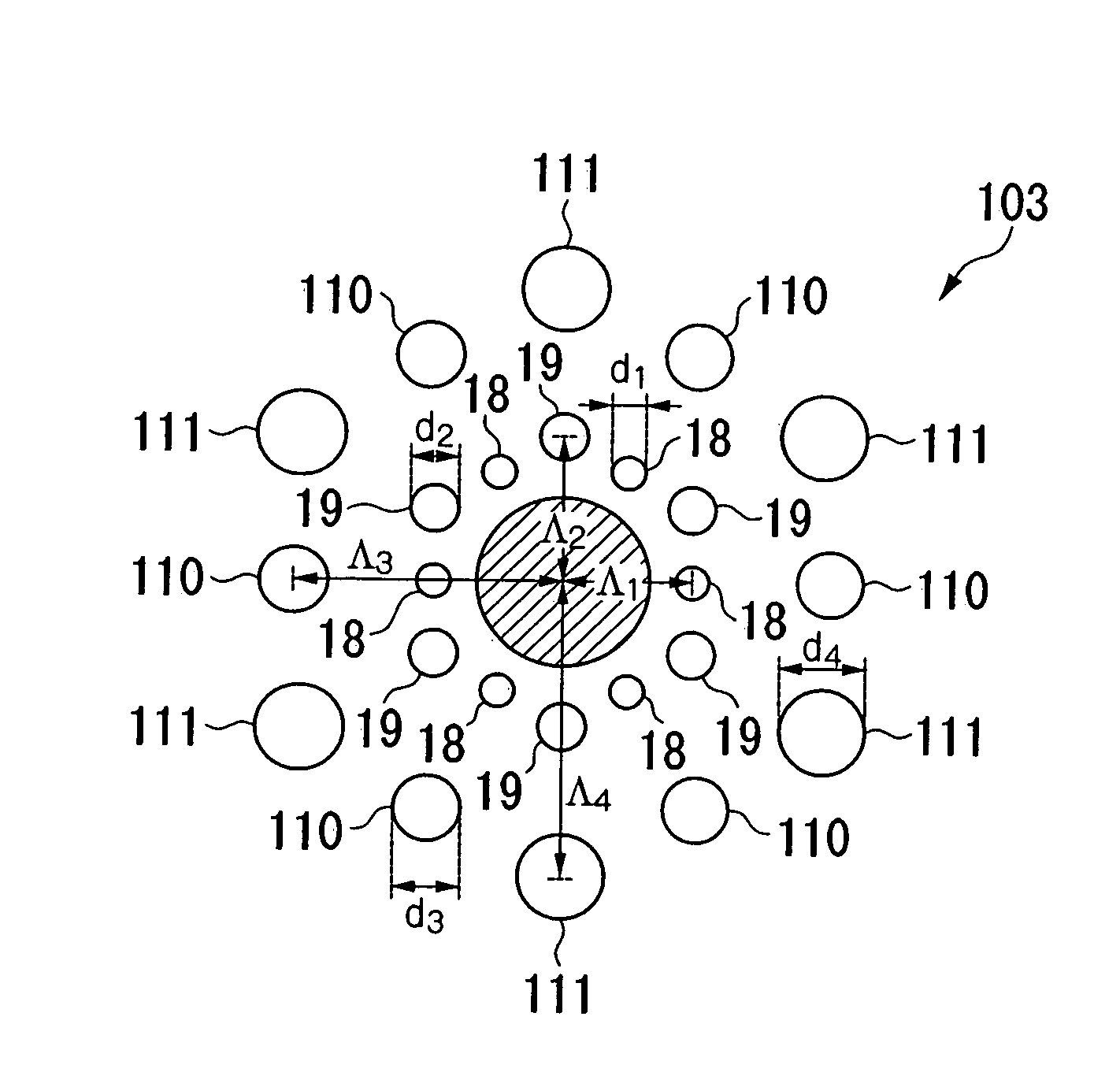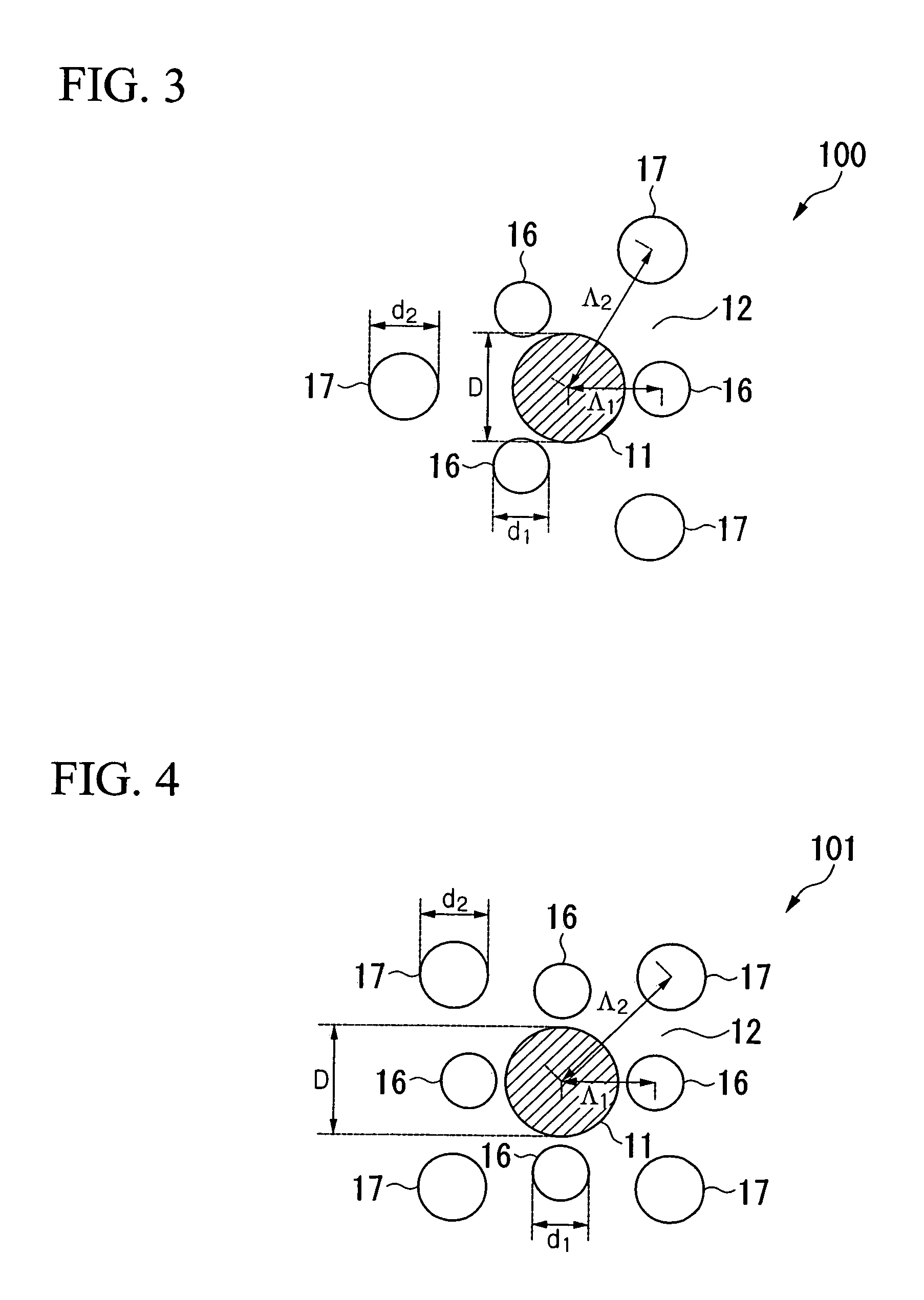Hole-assisted holey fiber and low bending loss multimode holey fiber
a multi-mode, hole-assisted technology, applied in the direction of instruments, optical waveguide light guides, optical light guides, etc., can solve the problems of increasing production costs, unable to completely eliminate the tradeoff between a lower bending loss and a longer cut-off wavelength, and unable to achieve both a short cut-off wavelength c/sub>and a low bending loss l/sub>b /sub>. , to achieve the effect o
- Summary
- Abstract
- Description
- Claims
- Application Information
AI Technical Summary
Benefits of technology
Problems solved by technology
Method used
Image
Examples
example 1
[0059]An HAHF having holes that formed two layers, i.e., the inner and outer layers, around the core region, in which the respective numbers of holes in the inner and outer layers were three, as shown in FIG. 3, was fabricated. The core region was formed from silica glass doped with GeO2, and the cladding region was formed from sure silica. The diameter D of the core region was 8.5 μm, and the relative refractive index difference Δ was 0.34%. For the inner hole layer, the hole diameter d1 was 5.1 μm, and the distance Λ1 from the center of the core region to the center of a hole was 8.5 μm. For the outer hole layer, the hole diameter d2 was 8.5 μm, and the distance Λ2 from the center of the core region to the center of the hole was 11.0 μm.
[0060]The characteristics of the fiber were measured as follows: a cut-off wavelength λC of the HAHF was about 1.24 μm and bending loss LB with a bending diameter φ of 10 mm at a wavelength of 1.55 μm was about 1.97 dB / m. Furthermore, fusion splice...
example 2
[0061]An HAHF having holes that formed two layers, i.e., the inner and outer layers, around the core region, in which the respective numbers of holes in the inner and outer layers were four, as shown in FIG. 4, was fabricated. The same materials as in the HAHF of Example 1 were used for the core region and the cladding region. The diameter D of the core region was 8.5 μm, and the relative refractive index difference Δ was 0.34%. For the inner hole layer, the hole diameter d1 was 3.6 μm, and the distance Λ1 from the center of the core region to the center of a hole was 7.5 μm. For the outer hole layer, the hole diameter d2 was 8.0 μm, and the distance Λ2 from the center of the core region to the center of the hole was 13.0 μm.
[0062]The characteristics of the fiber were measured as follows: a cut-off wavelength λC of the HAHF was about 1.28 μm and bending loss LB with a bending diameter φ of 10 mm at a wavelength of 1.55 μm was about 2.05 dB / m. Furthermore, fusion splice loss with an ...
example 3
[0063]An HAHF having holes that formed two layers, i.e., the inner and outer layers, around the core region, in which the respective numbers of holes in the inner and outer layers were six, as shown in FIG. 5, was fabricated. The same materials as in the HAHF of Example 1 were used for the core region and the cladding region. The diameter D of the core region was 8.5 μm, and the relative refractive index difference Δ was 0.34%. For the inner hole layer, the hole diameter d1 was 3.3 μm, and the distance Λ1 from the center of the core region to the center of a hole was 6.8 μm. For the outer hole layer, the hole diameter d2 was 6.8 μm, and the distance Λ2 from the center of the core region to the center of the hole was 14.0 μm.
[0064]The characteristics of the fiber were measured as follows: a cut-off wavelength λC of the HAHF was about 1.29 μm and bending loss LB with a bending diameter φ of 10 mm at a wavelength of 1.55 μm was about 1.70 dB / m. Furthermore, fusion splice loss with an S...
PUM
 Login to View More
Login to View More Abstract
Description
Claims
Application Information
 Login to View More
Login to View More - R&D
- Intellectual Property
- Life Sciences
- Materials
- Tech Scout
- Unparalleled Data Quality
- Higher Quality Content
- 60% Fewer Hallucinations
Browse by: Latest US Patents, China's latest patents, Technical Efficacy Thesaurus, Application Domain, Technology Topic, Popular Technical Reports.
© 2025 PatSnap. All rights reserved.Legal|Privacy policy|Modern Slavery Act Transparency Statement|Sitemap|About US| Contact US: help@patsnap.com



